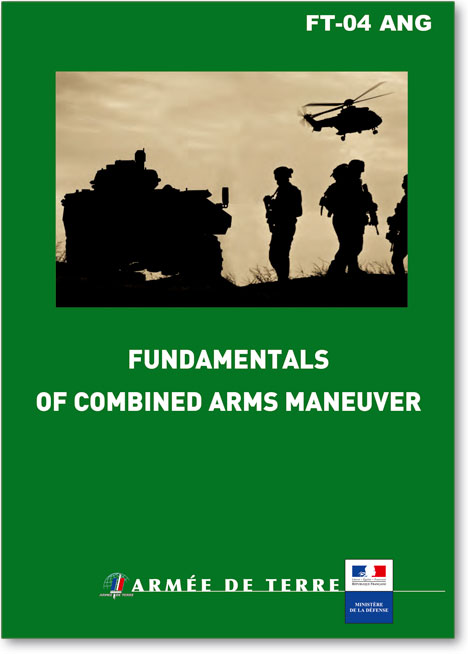January 2013. Consistent with NATO doctrine, this document is part of national doctrine and lays out the general manner in which the resources of land forces in operations must be combined for coherent employment, depending on the different commitment contexts which can be envisaged today. It excludes missions on the national territory.
FT-04 is part of the series of founding documents of the French Army's doctrine corpus and is coherent with joint documents. It is also intended as a reference for the drafting of employment doctrine for warfighting land functions.
Read the full document: FT-04 - Fundamentals of combined arms maneuver

This document describes broadly how a land force’s assets must be combined, in relation to the various currently foreseeable engagements. It serves as a reference for personnel developing warfighting doctrine as well as those conducting training, education and leadership development, force generation, planning and conduct of land operations. However, the contingencies of armed combat will always be a central parameter in any engagement. This doctrinal document in particular has therefore a dual objective:
- on the one hand, it is ambitious, demanding a coherent vision of combined arms operations from the Army’s planning and execution actors;
- on the other hand, it must be reasonably limited because its principles must in the end be adapted to the actual operational environment, whose reality is characterized by complexity and responsiveness. It is necessary to extrapolate and to combine the patterns outlined in this manual.
We consider operations across the spectrum of conflict, namely offense, defense, security and assistance while taking into account all possible adversaries (symmetric, dissymmetric and asymmetric).This document thus encompasses the doctrines specific to each military branch. It regroups field manuals governing the employment of combined arms brigades, battalion task forces and company teams, as well as those related to specific types or aspects of operations (urban or mountain areas, fire coordination, contact with populations, protection of facilities and/or convoys).
Land maneuver can be defined as the manner in which forces are committed on the battlefield. It combines movement, actual or potential fire and non-kinetic effects, so as to gain a physical and psychological advantage over the adversary while accomplishing the assigned mission.This maneuver typically employs combined arms at all tactical levels.
Table of contents
Foreword
I. Combined arms action
1.1. General Principles of Operations
1.2. Warfighting Functions of Land Forces and Their Components
1.3. Tactical Levels of Command and Employment
II. Types of operations
2.1. Types of Operations in the Strict Sense
2.2. Specific Features of Certain Commitments
III. The four universal functions of land maneuver
3.1. The Two Interdependent Functions of Command and Command Support
3.2. The Intelligence Function
3.3. The Logistics Function
IV. Land engagement warfighting functions
4.1. The Contact (Close Combat/Maneuver) Function
4.2. The Combat Support Function
4.3. The Maneuver Enhancement Function
4.4. The “Shaping Perceptions and the Operational Environment” Function
V. Specific and emerging aspects of current commitments
5.1. Fire Support Coordination at Lower Tactical Levels
5.2. The Use of Uavs (drones)
5.3. Forward Posts and Bases
5.4. Combating Ieds
5.5. Convoy Protection